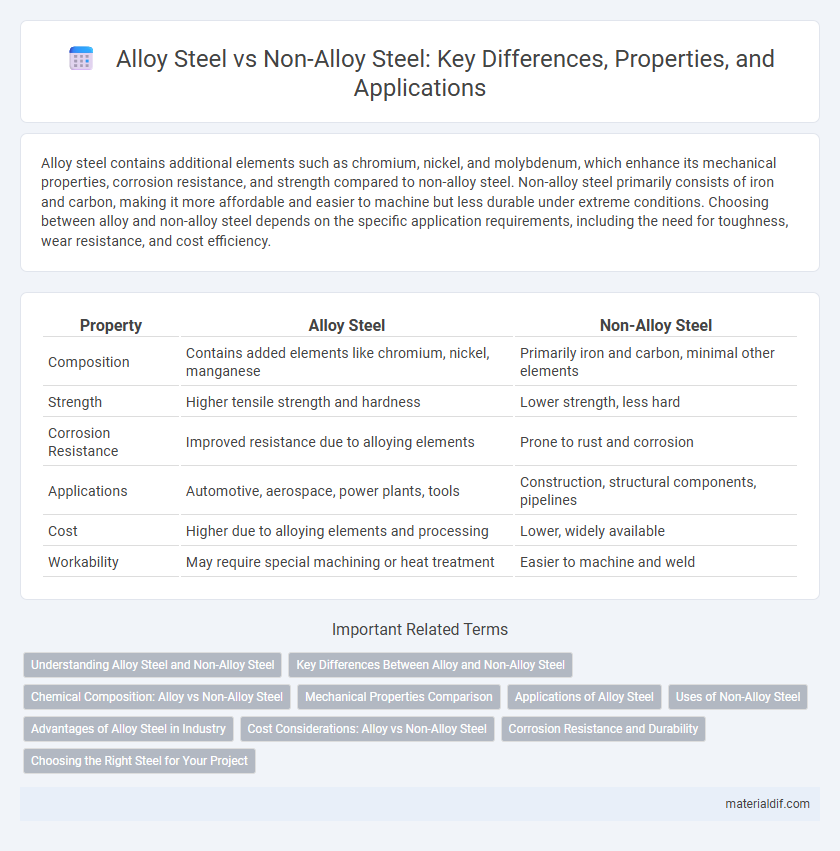Alloy steel contains additional elements such as chromium, nickel, and molybdenum, which enhance its mechanical properties, corrosion resistance, and strength compared to non-alloy steel. Non-alloy steel primarily consists of iron and carbon, making it more affordable and easier to machine but less durable under extreme conditions. Choosing between alloy and non-alloy steel depends on the specific application requirements, including the need for toughness, wear resistance, and cost efficiency.
Table of Comparison
| Property | Alloy Steel | Non-Alloy Steel |
|---|---|---|
| Composition | Contains added elements like chromium, nickel, manganese | Primarily iron and carbon, minimal other elements |
| Strength | Higher tensile strength and hardness | Lower strength, less hard |
| Corrosion Resistance | Improved resistance due to alloying elements | Prone to rust and corrosion |
| Applications | Automotive, aerospace, power plants, tools | Construction, structural components, pipelines |
| Cost | Higher due to alloying elements and processing | Lower, widely available |
| Workability | May require special machining or heat treatment | Easier to machine and weld |
Understanding Alloy Steel and Non-Alloy Steel
Alloy steel contains additional elements such as chromium, nickel, and manganese, which enhance its mechanical properties like strength, hardness, and corrosion resistance compared to non-alloy steel. Non-alloy steel, primarily composed of iron and carbon, offers good weldability and is cost-effective but lacks the enhanced durability and performance characteristics of alloy steel. Understanding the chemical composition differences is essential for selecting the appropriate steel type for applications requiring specific mechanical and environmental resistance properties.
Key Differences Between Alloy and Non-Alloy Steel
Alloy steel contains significant amounts of elements such as chromium, nickel, and molybdenum, which enhance properties like strength, hardness, and corrosion resistance, unlike non-alloy steel that primarily consists of carbon and iron. Non-alloy steel, also known as carbon steel, typically offers higher machinability and weldability but lacks the specialized mechanical properties found in alloy steel. The choice between alloy and non-alloy steel depends on application requirements, with alloy steels preferred in environments demanding durability and resistance to wear.
Chemical Composition: Alloy vs Non-Alloy Steel
Alloy steel contains significant amounts of alloying elements such as chromium, nickel, molybdenum, and vanadium, which enhance mechanical properties and corrosion resistance. Non-alloy steel primarily consists of iron and carbon, with minimal alloying elements, resulting in simpler chemical composition and moderate mechanical characteristics. The variation in chemical composition between alloy and non-alloy steel directly influences their application range and performance in different environments.
Mechanical Properties Comparison
Alloy steel demonstrates superior mechanical properties compared to non-alloy steel, including enhanced tensile strength, hardness, and resistance to wear and fatigue due to the addition of elements like chromium, nickel, and molybdenum. Non-alloy steel typically exhibits lower strength and ductility, making it suitable for less demanding structural applications where cost-effectiveness is prioritized. The controlled composition in alloy steel results in improved toughness and corrosion resistance, increasing its suitability for high-stress and extreme environmental conditions.
Applications of Alloy Steel
Alloy steel is commonly used in applications requiring enhanced mechanical properties, such as aerospace components, automotive parts, and heavy machinery, due to its improved strength, hardness, and resistance to wear and corrosion. It is preferred in manufacturing tools, pipelines, and structural elements where durability and performance under stress are critical. Non-alloy steel, while cost-effective, lacks the specialized properties necessary for high-stress environments, limiting its use primarily to construction and basic fabrication.
Uses of Non-Alloy Steel
Non-alloy steel is commonly used in construction, automotive manufacturing, and shipbuilding due to its excellent weldability and cost-effectiveness. Its applications include structural beams, pipelines, and automotive parts where high strength is necessary without the need for enhanced corrosion resistance or hardness. Non-alloy steel's versatility and ease of fabrication make it ideal for general engineering purposes.
Advantages of Alloy Steel in Industry
Alloy steel offers superior mechanical properties such as enhanced strength, hardness, and corrosion resistance compared to non-alloy steel, making it ideal for demanding industrial applications. Its ability to maintain performance under extreme temperatures and stress conditions ensures longer service life and reduced maintenance costs. These advantages lead to improved efficiency and reliability in sectors like automotive, aerospace, and construction.
Cost Considerations: Alloy vs Non-Alloy Steel
Alloy steel generally incurs higher costs due to the addition of elements like chromium, nickel, and molybdenum, which enhance mechanical properties and corrosion resistance. Non-alloy steel is more cost-effective, primarily composed of iron with minimal alloying, making it suitable for applications with less stringent performance requirements. Budget constraints often dictate the choice, as alloy steel's superior strength and durability justify its premium price in critical engineering applications.
Corrosion Resistance and Durability
Alloy steel contains elements such as chromium, nickel, and molybdenum that significantly enhance corrosion resistance and durability compared to non-alloy steel, making it ideal for harsh environments. Non-alloy steel, primarily composed of iron and carbon, is more susceptible to rust and wear, limiting its longevity in corrosive or high-stress applications. The presence of alloying elements in alloy steel forms protective oxide layers, providing superior strength and prolonged service life in demanding conditions.
Choosing the Right Steel for Your Project
Alloy steel contains added elements such as chromium, nickel, and molybdenum, enhancing its strength, durability, and resistance to corrosion, making it ideal for high-stress applications like construction and automotive manufacturing. Non-alloy steel, primarily composed of iron and carbon, offers cost-effective solutions with adequate strength for general-purpose projects such as building frameworks and machinery parts. Selecting the right steel depends on project requirements including mechanical properties, environmental conditions, and budget constraints, ensuring optimal performance and cost-efficiency.
Alloy Steel vs Non-Alloy Steel Infographic

 materialdif.com
materialdif.com